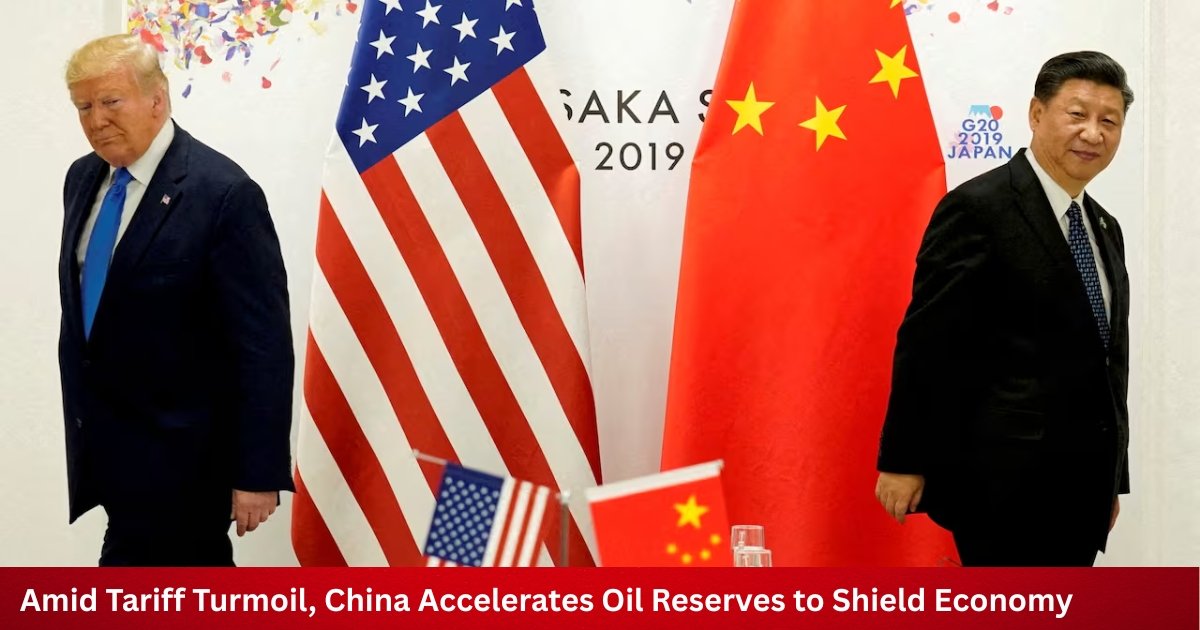
As trade tension escalates, China is swiftly expanding its oil reserve to safeguard its economy from the shocks of falling crude prices and ongoing tariff wars. Triggered by Trump’s aggressive tariffs, global oil markets are rattled, creating both risks and opportunities. Further, China’s strategic stockpiling signals a bold move to strengthen energy security amid uncertain economic times.
A Catalyst for China’s Oil Strategy
President Donald Trump’s aggressive tariff policies have significantly impacted global trade dynamics, particularly in the energy sector. The imposition of steep tariffs on Chinese imports has led to a sharp decline in U.S. crude oil exports to China, with shipments nearly zero.
Therefore, in response to these tariffs and the resulting drop in oil prices, China accelerated its oil stockpiling efforts in March. China’s crude oil storage surged, reversing earlier inventory draws. Such an increase was driven by a combination of surging imports and domestic products, leading to a surplus of 1.74 million barrels per day, which is the highest since June 2023.
Why Are Crude Prices Tumbling Amid U.S.-China Tensions?
Crude oil prices are tumbling due to ongoing U.S.-China trade wars and broader economic concerns. The key factors contributing to this decline are:
- Escalating U.S.-China Trade War: Recently, President Trump’s administration imposed a 104% tariff on Chinese imports. Thus, China was promoted to retaliate with 84% tariffs on U.S. goods, including crude oil. These actions have heightened concerns about recession, leading to decreased demand for commodities like crude oil.
- Surging U.S. Crude Inventories: U.S. crude oil inventories have risen for the second consecutive week, with a notable increase of 8.66 million barrels. Such surplus indicates weakened demand and contributes to downward pressure on prices.
- OPEC+ Output Increases: The Organization of the Petroleum Exporting Countries and its allies (OPEC+) decided to advance plans for output increases, aiming to return 411,000 barrels per day to the market in May 2025. Thus, such an influx of supply adds to concerns about oversupply in the market.
- Global Economic Slowdown Fears: The intensifying trade war has stroked fears of a global economic slowdown, which would reduce demand for crude oil. These concerns are reflected in the declining oil prices, with West Texas Intermediate (WTI) crude futures settling at $58.95 per barrel.
How China is Building Resilience Through Oil Reserves?
With the ongoing trade tensions with the U.S. and the volatile global energy market, China has intensified its focus on energy security by expanding its strategic oil reserves. Such an initiative aims to insulate the Chinese economy from external pressures, ensure a stable energy supply, and reduce dependence on foreign oil supply. Let’s find out how China is building resilience through oil reserves.
1. Increase in Strategic Oil Reserves
China has directed its state-owned oil companies to add approximately 60 million barrels of crude oil to its emergency stockpiles. Such a move represents one of the country’s most substantial stockpiling efforts in recent years, reflecting a proactive approach to energy security.
2. Diversification of Oil Sources
China continues to diversify its oil import sources, including increased purchases from Russia, Iran, and Venezuela. Therefore, the strategy reduces reliance on any single supplier and mitigates risks associated with geopolitical tensions.
3. Integration with a Broader Energy Strategy
The stockpiling efforts align with China’s broader energy strategy, emphasizing energy security, diversification of energy sources, and the development of renewable energy. The country’s 14th Five-Year Plan outlines goals to increase non-fossil fuel energy consumption and decrease carbon emissions, indicating a comprehensive approach to energy management.
Strategic Oil Reserves: China’s Shield Against Economic Volatility
China is intensifying its strategic oil reserve initiatives to resolve economic volatility and enhance security due to global uncertainties. The following points highlight the latest developments in China’s energy strategy:
- Development of New Storage Infrastructure: To support the stockpiling strategy, China is accelerating the construction of storage facilities for petroleum and other commodities. Therefore, the expansion aims to increase the country’s capability to maintain substantial reserves, thereby enhancing its ability to respond to future supply challenges.
- Discovery of Major Domestic Oil Fields: Recently, the China National Offshore Oil Corporation (CNOOC) announced the discovery of the Huizhou 19-6 oilfield in the South China Sea, with reserves exceeding 100 million tonnes. This significant finding is expected to bolster domestic oil production and reduce reliance on imports.
- Integration of Carbon Capture and Storage (CCS) Technologies: China is incorporating carbon capture and storage technologies into its oil extraction processes. For example, the Shengli Oil Field employs CO₂ injection methods for enhanced oil recovery, aligning with China’s commitment to decrease carbon emissions and achieving net-zero goals by 2060.
Inside China’s Plan to Fortify its Energy Security
The multifaceted approach by China encompasses strategic oil reserves, domestic production enhancements and infrastructure development. China’s plan includes:
- Development of Deepwater Oil and Gas Reserves: China has established a new state entity comprising national oil producers and other state-owned firms to explore ultra-deep oil and gas reserves. Therefore, such an initiative aims to address the challenges of extracting non-conventional resources and enhancing domestic production capacity.
- Promotion of Renewable Energy Sources: China is aggressively increasing its solar, wind, hydro, and nuclear power capacity. Such simultaneous push for renewables is driven by China’s vast demand, industrial needs, and the desire to maintain energy security while also aiming for long-term carbon neutrality by 2060.
- Implementation of a Unified Energy System: China is working towards building a national unified energy system, encompassing a fair and open national oil and gas market. The step is to streamline energy distribution and enhance efficiency across the country.
Conclusion
China’s accelerated oil stockpiling and energy security strategy reflect its proactive approach to safeguard economic stability amid global uncertainty. By diversifying supply sources, expanding reserves, and integrating advanced technologies, China is reinforcing its resilience against energy volatility. Thus, it ensures long-term stability and reduces dependence on external markets.
